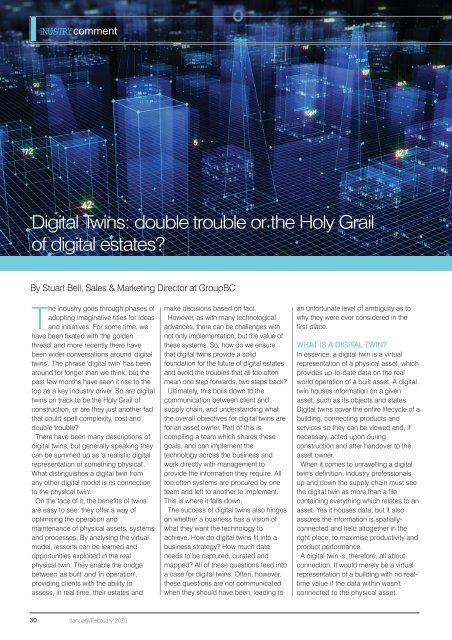CU Jan-Feb 2020
You also want an ePaper? Increase the reach of your titles
YUMPU automatically turns print PDFs into web optimized ePapers that Google loves.
INUSTRY comment<br />
Digital Twins: double trouble or the Holy Grail<br />
of digital estates?<br />
By Stuart Bell, Sales & Marketing Director at GroupBC<br />
The industry goes through phases of<br />
adopting imaginative titles for ideas<br />
and initiatives. For some time, we<br />
have been fixated with 'the golden<br />
thread' and more recently there have<br />
been wider conversations around 'digital<br />
twins'. The phrase 'digital twin' has been<br />
around for longer than we think, but the<br />
past few months have seen it rise to the<br />
top as a key industry driver. So are digital<br />
twins on track to be the Holy Grail of<br />
construction, or are they just another fad<br />
that could spell complexity, cost and<br />
double trouble?<br />
There have been many descriptions of<br />
digital twins, but generally speaking they<br />
can be summed up as 'a realistic digital<br />
representation of something physical'.<br />
What distinguishes a digital twin from<br />
any other digital model is its connection<br />
to the physical twin'.<br />
On the face of it, the benefits of twins<br />
are easy to see: they offer a way of<br />
optimising the operation and<br />
maintenance of physical assets, systems<br />
and processes. By analysing the virtual<br />
model, lessons can be learned and<br />
opportunities exploited in the real<br />
physical twin. They enable the bridge<br />
between 'as built' and 'in operation',<br />
providing clients with the ability to<br />
assess, in real time, their estates and<br />
make decisions based on fact.<br />
However, as with many technological<br />
advances, there can be challenges with<br />
not only implementation, but the value of<br />
these systems. So, how do we ensure<br />
that digital twins provide a solid<br />
foundation for the future of digital estates<br />
and avoid the troubles that all too often<br />
mean one step forwards, two steps back?<br />
Ultimately, this boils down to the<br />
communication between client and<br />
supply chain, and understanding what<br />
the overall objectives for digital twins are<br />
for an asset owner. Part of this is<br />
compiling a team which shares these<br />
goals, and can implement the<br />
technology across the business and<br />
work directly with management to<br />
provide the information they require. All<br />
too often systems are procured by one<br />
team and left to another to implement.<br />
This is where it falls down.<br />
The success of digital twins also hinges<br />
on whether a business has a vision of<br />
what they want the technology to<br />
achieve. How do digital twins fit into a<br />
business strategy? How much data<br />
needs to be captured, curated and<br />
mapped? All of these questions feed into<br />
a case for digital twins. Often, however,<br />
these questions are not communicated<br />
when they should have been, leading to<br />
an unfortunate level of ambiguity as to<br />
why they were ever considered in the<br />
first place.<br />
WHAT IS A DIGITAL TWIN?<br />
In essence, a digital twin is a virtual<br />
representation of a physical asset, which<br />
provides up-to-date data on the real<br />
world operation of a built asset. A digital<br />
twin houses information on a given<br />
asset, such as its objects and states.<br />
Digital twins cover the entire lifecycle of a<br />
building, connecting products and<br />
services so they can be viewed and, if<br />
necessary, acted upon during<br />
construction and after handover to the<br />
asset owner.<br />
When it comes to unravelling a digital<br />
twin's definition, industry professionals<br />
up and down the supply chain must see<br />
the digital twin as more than a file<br />
containing everything which relates to an<br />
asset. Yes it houses data, but it also<br />
assures the information is spatiallyconnected<br />
and held altogether in the<br />
right place, to maximise productivity and<br />
product performance.<br />
A digital twin is, therefore, all about<br />
connection. It would merely be a virtual<br />
representation of a building with no realtime<br />
value if the data within wasn't<br />
connected to the physical asset.<br />
30<br />
<strong>Jan</strong>uary/<strong>Feb</strong>ruary <strong>2020</strong>

















